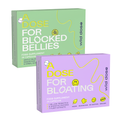Water retention can occur in any area of the body, but it’s most common in the abdomen and peripheries (hands, lower legs, and feet). It is medically known as oedema and can range from mild to severe. Oedema can add between two and ten kilograms to a person’s body weight!
There are many reasons why you might experience bloating and puffiness, including hormonal changes, dietary factors, and the presence of medical health conditions, particularly those that impact fluid regulation, like cardiovascular diseases, renal disease, or diabetes. I have covered these in detail below.
Thankfully, if you’re dealing with swollen ankles or abdominal bloating, there are many things you can do to tackle this issue. Some herbs are known to help reduce water retention, one of which is dandelion root. Whilst there is still more research needed to show the benefits of dandelion root for treating water retention, this herb is showing some promising results.
Keep reading to learn more about water retention and the use of dandelion root as a natural remedy for reducing water retention, puffiness, and swelling.
What Is Water Retention?
Water retention (oedema) is the accumulation of fluids within the body tissues. It causes swollen hands, lower legs, and feet and can also impact the face and abdomen, causing puffiness in these areas of the body.
Oedema can range from mild to severe, with the former being much less noticeable. If severe, you can experience pitting oedema, where the skin looks indented, and the capillary refill time is relatively long (the time taken for blood to flow back into the capillaries when you lightly press your skin).
Water retention manifests with the following symptoms:
- Swelling in the lower legs and feet
- Puffiness in the face and hands
- Bloating in the abdominal region
- Tightness under the skin
- Joint swelling and stiffness
- Weight gain due to excess fluids in the body
- Skin that appears shiny, transparent, or slightly purple
- Shortness of breath, dizziness, and weakness
What Causes Water Retention?
Although there are several causes of oedema, the physiological cause of it is the movement of fluid from the bloodstream to the interstitial fluid (the areas between the cells in the tissues).
Water moves from an area of high concentration to an area of low concentration down what is known as a concentration gradient (a process known as osmosis). Water constantly moves from the blood to the tissues but gets pumped back into the bloodstream shortly after. However, if something impairs the ‘pumping’ process, water remains in the tissues for longer than it should.
There are lots of different things that impair the reabsorption of water into the bloodstream, including the following:
- Low plasma protein (caused by a low-protein diet or poor protein absorption or metabolism)
- Increased salt intake (this causes the kidneys to reabsorb more water (due to concentration gradients in the renal tubules), leading to water retention)
- Gravity (caused by standing up for long periods of time)
- Being sedentary (sitting down for extended periods can cause blood to pool in your lower legs and disrupt the natural movement of water between the blood and tissues)
- Hormonal fluctuations (this may be caused by the menstrual cycle, pregnancy, or menopause)
- Stress (cortisol can disrupt fluid balance within the body and increase bloating and puffiness)
- Dehydration (the body compensates for a lack of fluids by retaining more water, causing fluid accumulation)
- Injuries, trauma, or allergic reactions (causing an inflammatory response that increases blood flow to the affected area of the body)
- Antidiuretic medications, such as ADH (vasopressin), argipressin, desmopressin, or oxytocin (these medications cause the kidneys to reabsorb more salt and water into the bloodstream)
- Chronic health conditions that impact fluid balance, such as cardiovascular diseases, kidney disease, diabetes, or irritable bowel syndrome (IBS)
How Does Dandelion Root Help With Water Retention?
Dandelion root has been used as a natural remedy for water retention for a long time. It has known diuretic properties, meaning it encourages the body to eliminate more water by increasing water excretion in the kidneys.
So, how does dandelion root help to tackle puffiness and bloating?
Natural diuretic effects
Dandelion root contains two key compounds called taraxasterols and taraxerol, which have diuretic properties. They promote water removal in the kidneys, causing you to urinate more and eliminate excess fluids from your body. In turn, dandelion root can reduce water retention and bloating.
Source of potassium
Dandelion root is a great source of potassium, a mineral that is essential for fluid balance within the body. Many pharmaceutical diuretics deplete potassium, which can lead to issues with nerve impulse transmission and muscle contraction, particularly within the heart. Severe potassium deficiency can even lead to cardiac arrhythmias (irregular heartbeat).
Because dandelion is rich in potassium, it helps to negate the potassium, depleting effects of diuretics. It ensures electrolyte balance whilst still promoting increased fluid excretion in the kidneys to tackle oedema.
Anti-inflammatory properties
Both chronic and acute inflammation can contribute to water retention by increasing blood flow and capillary permeability, causing more fluid to leak into the surrounding tissues.
Dandelion root contains bioactive plant compounds, including flavonoids and polyphenols, that have natural inflammation-reducing effects. They can lower swelling and fluid retention to tackle oedema of all securities.
Antioxidant properties
Alongside reducing inflammation, dandelion root can lower oxidative stress in the body. It is rich in vitamin C, vitamin E, and beta-carotene, all of which can neutralise free radicals, preventing them from damaging the cells.
Cell and tissue damage caused by oxidative stress can increase inflammation, which, in turn, can increase water retention. Therefore, taking dandelion root can help to indirectly tackle oedema through its antioxidant activity.
Improved digestive health
Digestive disorders, such as IBS, Crohn’s, and ulcerative colitis, are commonly associated with increased fluid retention and bloating. Dandelion root may support healthy digestive functions to manage these conditions and minimise the side effects of abdominal bloating, subcutaneous puffiness, and water retention in the peripheries.
What Are Other Natural Remedies for Water Retention?
Alongside taking dandelion root, there are lots of additional things you can do to keep water rendition at bay and hydrate your body appropriately without the risk of bloating. Here are my top oedema-busting strategies, including dietary adjustments and lifestyle changes.
Take a probiotic supplement around mealtimes
Probiotic supplements are beneficial for your digestive system. They supplement your endogenous (natural) probiotic bacteria, which are found in your gut. Probiotic bacteria act as part of the immune system, preventing harmful pathogens from entering your bloodstream through the digestive tract.
Probiotic bacteria also help to produce vitamins and other beneficial compounds (such as short-chain fatty acids) that promote a healthy brain and body. They promote better and more efficient digestion to minimise the risk of bloating and associated digestive symptoms.
A Dose For Bloating tackles digestive symptoms with full force. It contains dandelion root alongside five other plant extracts, a million probiotic bacteria, and six different digestive enzymes. This bloat-busting supplement will help to alleviate puffiness, swelling, and water retention, and you’ll see results within just a week or two of taking it daily.
Manage chronic health conditions effectively
Management of chronic health conditions, especially those that influence fluid balance within the body, is essential for reducing water retention. Oedema is a symptom of many chronic health conditions, including diabetes, cardiovascular disease, kidney disease, and thyroid issues.
Work with a team of healthcare professionals who can help you manage your condition effectively and ensure your symptoms, including bloating and water retention, are kept to a minimum. Follow the advice provided by the healthcare professionals looking after you to ensure optimal health.
Don’t be afraid to ask questions and raise your concerns if there is something bothering you or if your symptoms appear to be worsening. Your healthcare providers are there to help, and no question is a silly question!
Consume natural bloat-relieving foods
there are lots of plant-based foods that act as natural bloat relievers and diuretics. These foods include avocados, garlic, onions, ginger, turmeric, and lemon.
Consuming more of these foods can help with the elimination of excess fluids from the body, reducing water retention and bloating. Consider switching your morning coffee to a cup of ginger tea or turmeric latte, adding lemon to your curries, or cooking more with onions and garlic.
Focus on potassium-rich foods and avoid excessive sodium
Potassium and sodium are responsible for regulating fluid balance in your body. Potassium promotes water excretion, whilst sodium promotes water reabsorption in the kidneys.
Therefore, consuming more of the former can help to rid the body of excess fluids and alleviate swelling. Consuming excessive amounts of sodium can have the opposite effect and may cause your body to hold onto more water, worsening your oedema and bloating.
Potassium-rich foods include avocados, dried fruit, bananas, apples, oranges, leafy green vegetables, tomatoes, carrots, and potatoes. Eating more of these foods will boost your intake of this essential mineral and help to target existing puffiness.
Sodium-rich foods tend to be those that are pre-packaged, like ready meals and salty snacks, or takeaways. Whilst you can still enjoy these foods in your diet, do so every once in a while instead of all the time if you want to keep water retention to a minimum.
Balance your hormones if possible
Underlying health conditions may cause hormonal imbalances and hormone-related bloating, and, in this case, they can be difficult to address. However, you might be experiencing hormonal imbalances due to modifiable behaviours.
For example, if you’re somebody who enjoys training in the gym and tends to work out every single day, you might be doing a little too much and causing excess physical stress on your body. Overtraining can negatively impact your hormones and disrupt your menstrual cycle if you’re a woman.
Reducing your exercise could help to address the resulting hormonal imbalances and reduce water retention, especially if the hormones in question contribute to fluid regulation in the body. Oestrogen and progesterone can contribute to water retention, and their production within the body is influenced by things like overtraining or undereating.
Additional modifiable factors for balancing your hormones include managing your weight, eating a nutritious diet, avoiding smoking, and avoiding alcohol. By leading an overall healthy lifestyle, you can maintain healthy cardiovascular, renal, and liver functions, contributing to fluid balance and reducing the risk of oedema.
Elevate your legs when sitting down
If you mainly have lower body oedema that causes water to pool in your lower legs and ankles, you might find benefit in elevating your legs when you’re sitting down. Keeping your legs at hip height or above can help your heart pump blood back up from the extremities and drain excess fluids from the lower body tissues more effectively.
Wear compression stockings
They may not be the sexiest thing in the world, but compression stockings are incredible for your circulation. They are often provided to patients following surgery to aid blood flow in the lower legs and reduce the risk of blood clots. However, they can also be beneficial for everyday usage when you have oedema around your calves and ankles.
Invest in a pair of high-quality compression stockings that you can wear when you’re sitting down at work, standing for long periods, or travelling, to minimise oedema.
Avoid dehydration or over-hydration
Both a lack of fluid intake and consuming too much fluid can lead to water retention. If your body doesn’t have enough fluid available because you’re not drinking enough, it will compensate by holding onto more water, leading to swelling and bloating.
Conversely, consuming too much water can cause it to build up where it shouldn’t, such as in the interstitial spaces between the cells in your tissues. In turn, you can experience more water retention and puffiness if you’re over hydrating your body.
The recommendation is around 2 - 2.5 litres of water a day, but this can vary depending on your weight, body composition, physical activity levels, and location (if it’s sunny and hot where you live, you’ll need to drink more water to make up for the fluids you’re losing in sweat). It’s best to take regular sips of water throughout the day to avoid feeling thirsty in the first place, as thirst is the first sign of dehydration.









